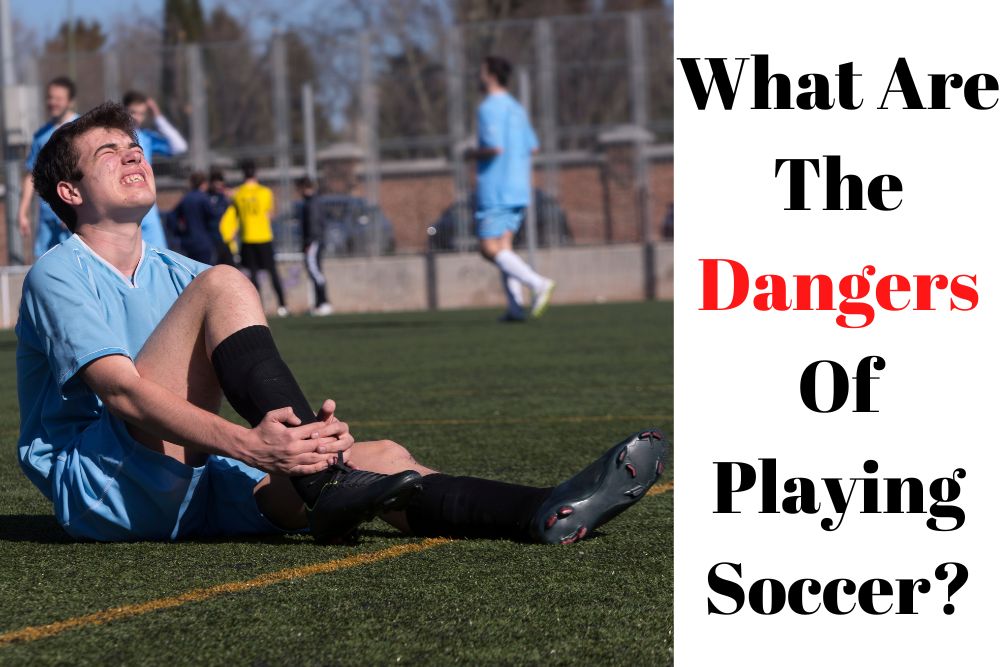Soccer is one of the world’s most popular sports with participants from individuals of all age groups. This sport involves numerous skills and actions such as kicking, heading, turning, pivoting, cutting, jumping, acceleration, and deceleration.
Some of the skills allowed in soccer make the game relatively dangerous to engage in especially in cases like street soccer where well-structured regulations and safety measures are not put in place to keep players properly secure.
Due to the high emphasis on players’ physical and technical skills, injuries are bound to occur at a certain frequency although not often major injuries. Most injuries in soccer are recorded from tackles, falls, and player contact.
This sport might be a bit riskier to play if you haven’t been trained the right way or when you neglect to wear the right set of gear. For instance, wearing the wrong-sized soccer cleats can cause blisters and some other painful injuries.
Even though playing soccer has its dangers, it is relatively safer than some high-contact sports like American football and boxing where injury rates are quite high. Most parents would prefer their kids to play soccer than any other contact sports out there.
Soccer becomes more dangerous and more injuries are recorded when the pace of the game increases. For example, when both teams on the field are seriously trying to secure a late victory, that is mostly when caution is thrown to the wind. What follows next is often a series of major and minor injuries.
In case you are a parent looking for a safe sport to enroll your kid in or you are an independent young athlete making plans to play soccer professionally, this article will tell you all you need to know about the dangers of playing soccer and how to safely engage in the sport.
Quick Navigation
What are the dangers of playing soccer?
So, is soccer as dangerous as some people believe it to be? To properly answer this question, there are a couple of things we need to take into consideration.
Over the years, the pace and competitiveness of soccer have increased greatly. Like every other contact sport, there is always a possibility that the level of danger that comes with playing the sport will also increase.
Every player wants to become the best in the world and will often push their pace and aggression to get the desired attention. So, soccer is not that dangerous.
The problem is that we are getting more desperate soccer players who throw caution to the wind in their desire to impress their coaches and the fans.
We shall be looking at some of the known dangers of playing soccer below starting with the biggest and most dreaded one, injuries.
Injuries
Soccer injuries can be minor and keep players out for a few weeks or major leading to the premature termination of a soccer career. Injuries are so dreadful that they can give soccer players sleepless nights thinking about them.
The most common minor injuries associated with playing soccer include broken toes, broken nails, sprains, muscular injuries, soccer cramps, torn meniscus, etc.
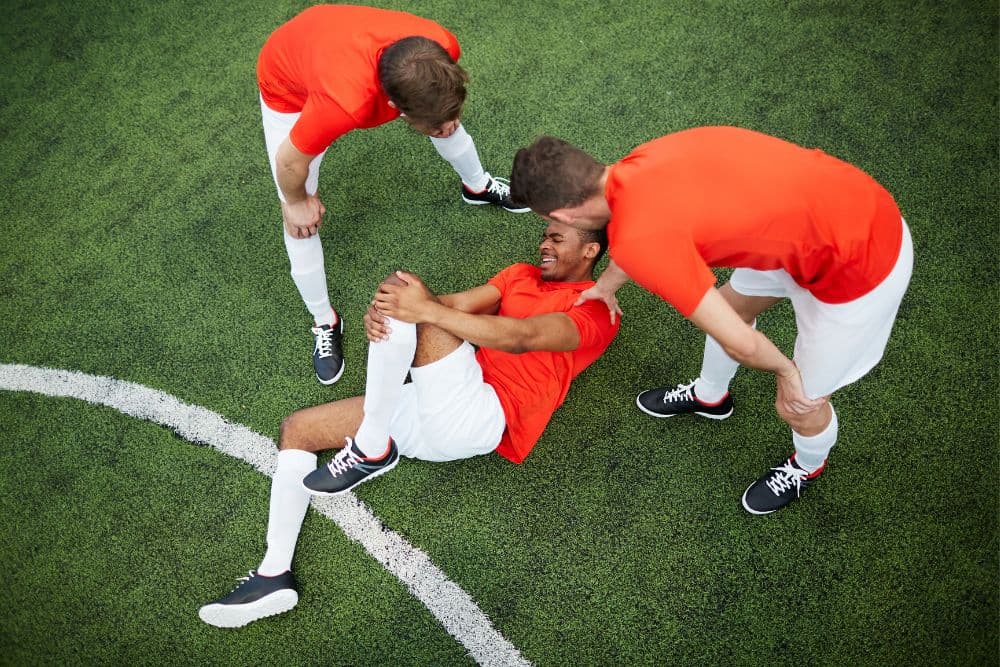
Some of the dangerous impacts or hits witnessed in soccer which can cause serious injuries and suffering to players include:
- Head-on-collision which normally occurs when two players try heading the ball in the air at the same time
- Straight hit from opponent players using their knee, feet, elbow, head, or any other hard part of their body. Such hits can knock out players depending on how much force was applied while delivering them
- A direct powerful shot to the face or delicate parts of the body like the male genitalia which we see often during freekicks. Such hits can get players substituted from a match
- Being mistakenly stepped on the chest or other delicate parts of your body while lying down on the pitch
- Stumping on another soccer player leads to dislocation. In Everton’s 1-1 draw with Tottenham on 3 November 2019, Andre Gomes suffered a horrific ankle injury in the 79th minute after being stamped on by Tottenham’s Son Heung-min.
Most of these hits aren’t always done intentionally but inevitable because of the speed of the game. Players sometimes get punished or penalized by referees even when it is evident that their wrong action wasn’t intentional.
Contact is permitted in soccer but not extreme contact. Sometimes, in certain situations, you are free to meticulously cover the ball from opponents or retrieve balls from opponents using the strength of your body.
There are always limits to the level of contact players are allowed to have among themselves in the game of soccer. For instance, slide tackle is permitted but not when your target is your opponent’s legs and not the soccer ball. Pushing or colliding into opponents with extreme force isn’t allowed.
The use of your elbow when warding off opponents is not acceptable and it can even earn you a red card or a match ban if you aren’t lucky. Without the long list of rules of the game, soccer would have been a very dangerous sport to play.
Most common soccer injuries
Players in certain positions in soccer are more prone to injuries than others. Our research shows that the most dangerous position in soccer is the goalkeeper position even though injuries aren’t recorded frequently.
The forward position records a higher frequency of injuries in all major and minor leagues in the world. However, goalkeeper injuries are usually more severe when they occur.
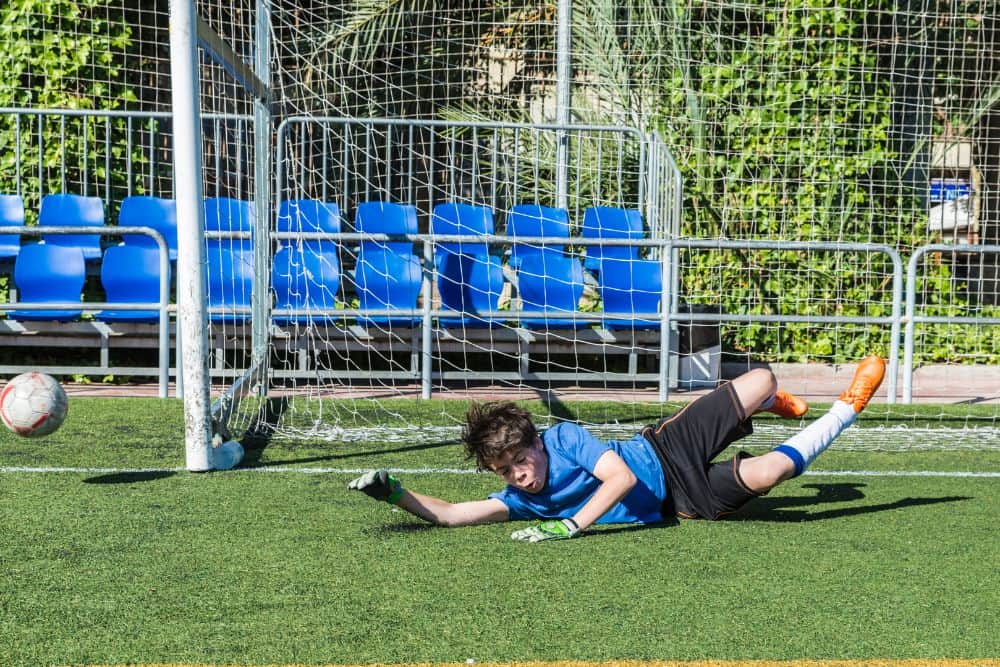
Goalkeepers are more vulnerable to injuries like ankle and knee injuries, hip and groin-related problems, and head injuries from goalpost collisions, to name a few. Some other common soccer injuries include:
Kneecap bursitis
The kneecap bursitis is a common injury amongst soccer players mostly caused by direct trauma to the knee. It causes inflammation and pain in the pes anserine bursa which is located on the inner layer of the knee beneath the joint.
It often heals by itself when it isn’t caused by an infection. Players affected by this injury must try to stay off the game for a while so they can adequately rest the affected joint area so it can heal faster.
Concussion
The San Diego Division of Pediatric Neurosurgery at Rady Children’s Hospital states that as much as 22% of soccer-related injuries are often concussions. A good percentage of professional soccer players have experienced a concussion at least once in their soccer career.
A head collision can cause bleeding in the brain which can degenerate into a secondary impact syndrome if the player affected keeps playing without being properly attended to. Players need to take a break to get proper medical attention after a collision or taking a nasty kick to the head.
Meniscal tear
This injury is mostly caused by severe knee sprains. It can cause severe pain in the leg which can lead to loss of proper function. When affected by a meniscal tear, it is essential to stop walking with the injured leg for a while.
You can also splint the knee in a relaxed position to help it heal faster. This injury shouldn’t be ignored to avoid it turning into something more severe.
This injury isn’t only common among goalkeepers but also among young soccer players.
The most common kind of this fracture is the buckle fracture that occurs at the end of the radius bone located near the wrist. A short arm cast worn for about a month can heal this injury.
Foot fracture
Among soccer players, weight-bearing bones like the leg or foot are more prone to stress fractures. Stressing these bones repetitively weakens them and causes them to begin to break down gradually.
A strong impact or direct blow to the foot can cause traumatic fractures which can affect the metatarsal and ankle bones, this fracture can keep a soccer player away from the pitch for a long time if not properly attended to.
Preventive measures against soccer injuries
There are many preventive measures to avoid soccer injuries but the most effective of all is playing with caution and intelligence. Aggressive players who always make brute choices on the soccer pitch are often prone to severe injuries.
With the few tips below, you will be able to properly protect yourself from soccer injuries that can keep you away from playing for a while or even end your career.
- Always wear the right-sized soccer boots
- Wear protective gear like shin guards and athletic cups which can reduce the impact of hits
- Use your common sense more than you use your physical strength on the pitch
- Apply and obey the rules of fair play
- Stay hydrated especially when the weather is hot
- Maintain good physical fitness by working out regularly, especially before the start of the game
- Take a break from playing soccer until you fully recover from injuries
- Don’t try skills and techniques you are not familiar with
Depression
Looking at the huge salary and luxurious lifestyles of most professional soccer players, you might be carried away into thinking that they don’t suffer from sadness and depression. Studies show that playing position and arguments on the pitch can affect players negatively.
Soccer often exerts intense mental pressure on players which can make them susceptible to burnout and depression. Losing crucial games, especially by missing penalties is often responsible for putting players under undue distress, pain, sadness, and eventually depression.
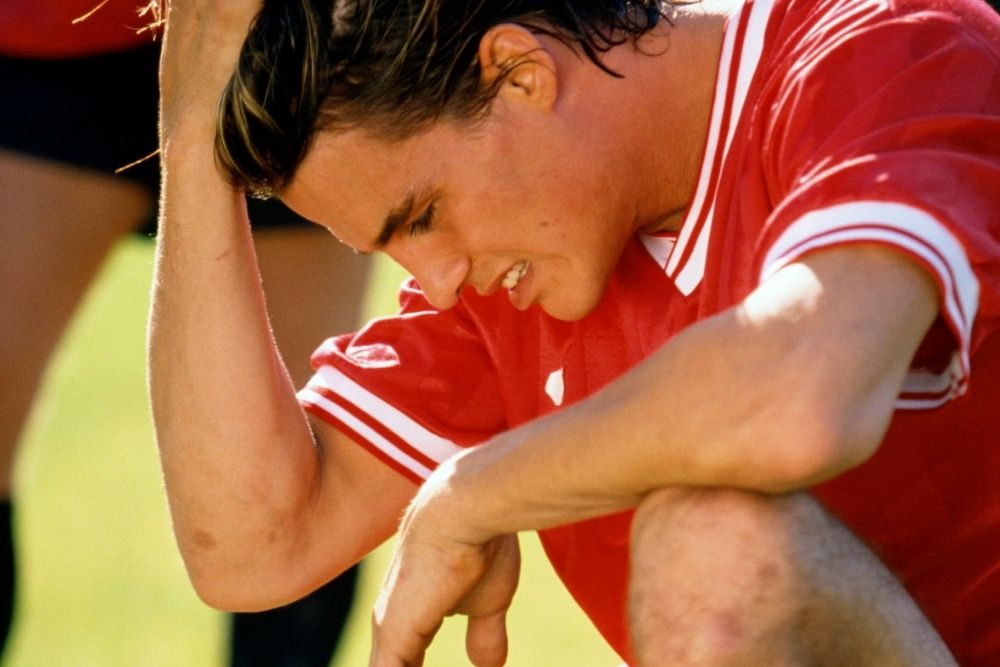
Depression is characterized by unpleasant feelings like loss of interest in activities you loved engaging in, despair, hopelessness, and sadness. It can also be accompanied by a lack of desire for any physical activities.
Research has found that sports people, especially soccer players, are prone to higher levels of depression compared to regular individuals. Certain factors which might be responsible for this irregularity include;
- The huge responsibility that comes with playing in a team with many exceptional players. The difficulty in keeping up with these players often triggers depression
- Separation from family and friends over a long period can increase lonely feelings and lack of social support which makes players vulnerable to depression
- Intense mental demand and immense pressure from management and fans
- The high standards of the game often breakdown or burnout players who aren’t physically and mentally tough enough
- Injuries can put players in a bad state where negative feelings and depressing thoughts may overwhelm them
- Negative and false media content about soccer players can also cause them to become depressed especially when their fans believe such stories
There are many more reasons that can drive soccer players into depression. Even famous professional soccer players aren’t exempted from this.
English defender Danny Rose was praised in 2018 for publicly opening up about his tenacious battle with depression which resulted from a series of unfortunate events he faced in his soccer career at that period.
Even the well-decorated Spanish professional soccer player Andres Iniesta once battled a bout of depression after suffering from soccer-related injuries and other sad episodes which made it difficult for him to be in top form during the 2010 World Cup.
Death
Another danger of playing soccer is paying the ultimate price. Aside from health-related issues, sometimes, players get mobbed and killed by angry fans for causing a team’s defeat.
The incident where soccer players die on the pitch during training or matches isn’t something new. Several such events have been caught on camera.
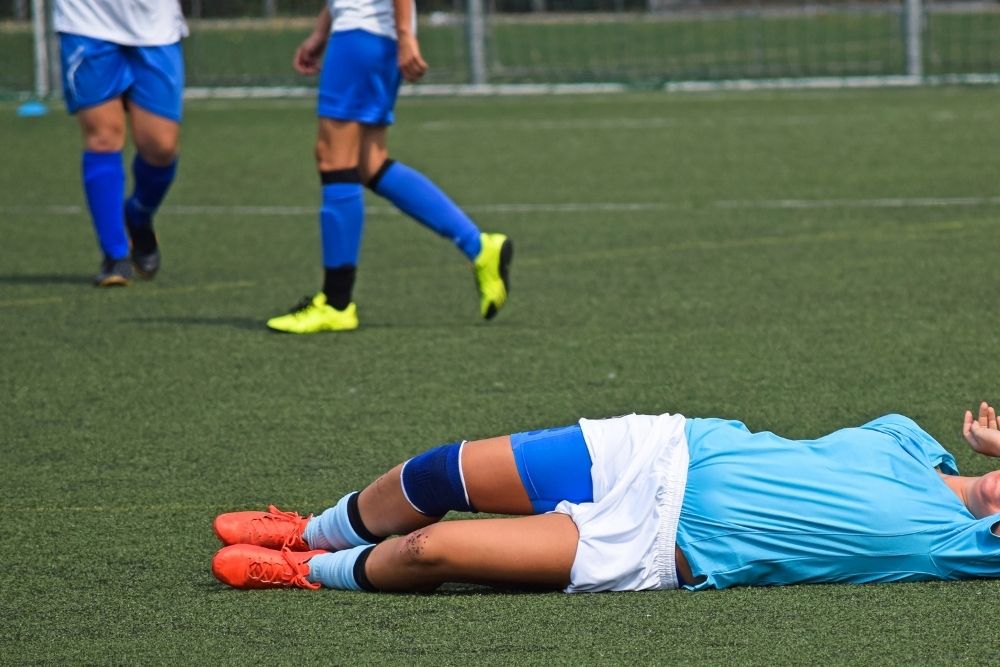
Due to the increase in the frequency of the death of soccer players on the pitch, The International Federation of Association Football (FIFA) 2007 requested a mandatory cardiac test for all players.
Although cardiac arrests and heart failures are oftentimes the most common cause of a player’s sudden death on the pitch, injuries from dangerous tackles can also lead to a player’s death although such incidents rarely occur.
Natural elements like lightning can also result in the death of soccer players on the pitch. Two unfortunate players Giovanni Cordoba and Hernan Gaviria were both killed on the pitch after being struck by lightning while training with their Colombian team Deportivo Cali in the year 2002.
A similar incident also occurred 3 years later when a pair of amateur Guatemalan players Jose Luis Mejia and Edgar Lopez met their untimely death after being struck by lightning shortly after officials canceled their match in regards to the looming bad weather.
Drugs and alcohol addiction
The pressure to always perform optimally all the time has become one of the constant struggles of soccer players and other athletes. In an attempt to keep up, some soccer players get involved in performance-enhancing drugs.
The use of narcotics among players is widespread because of the belief that it helps them to play through pain and is also capable of cutting down their recovery time.

Key players are often given doses of painkillers so that they can feature in really important games. Scenarios like this have continued to spread the opioid epidemic sweeping through the United States.
The excessive use of painkillers like opioids can lead to addiction and drug abuse which can further progress into the use of heroin.
Former Chelsea’s Adrian Mutu was once fined a huge sum of money for failing a drug test. Even world-famous soccer player Diego Maradona of Argentina was also fined 70,000 dollars for missing games after abusing cocaine.
The strong use of alcohol is also recorded among professional soccer players. Alcohol dehydrates the body and causes behavioral changes, intoxication, a decline in performance, and other adverse effects.
Former England and Arsenal midfielder Paul Merson also battled with a couple of addictions ranging from alcohol to drugs and even gambling during his soccer career.
It is essential to seek professional help when you get hooked on either drugs or alcohol because aside from destroying relationships, such addictions are capable of causing severe health issues and even death.
Conclusion
The dangers attributed to playing soccer are numerous but not as perilous as mostly projected. With the use of the right protective gear or equipment, taking adequate care of yourself, and obeying rules and match officials, soccer can become as safe as you could ever imagine.
Injuries associated with playing soccer occur as a result of making careless choices on the pitch. Soccer is practically safer than most contact sports such as American football and boxing.
You have no reason to panic if your kids say they love playing soccer. Just understand the risk factors and dangers faced by soccer players and find out their preventive measures.
While it is true that virtually all soccer players have had to deal with various degrees of injuries, most of such injuries are avoidable.
Hi there, I’m Jay.
Soccer is everything in my life! My friends and I have created this blog with all our enthusiasm, passion, and understanding after years of playing pro soccer. Hope you will enjoy it!
